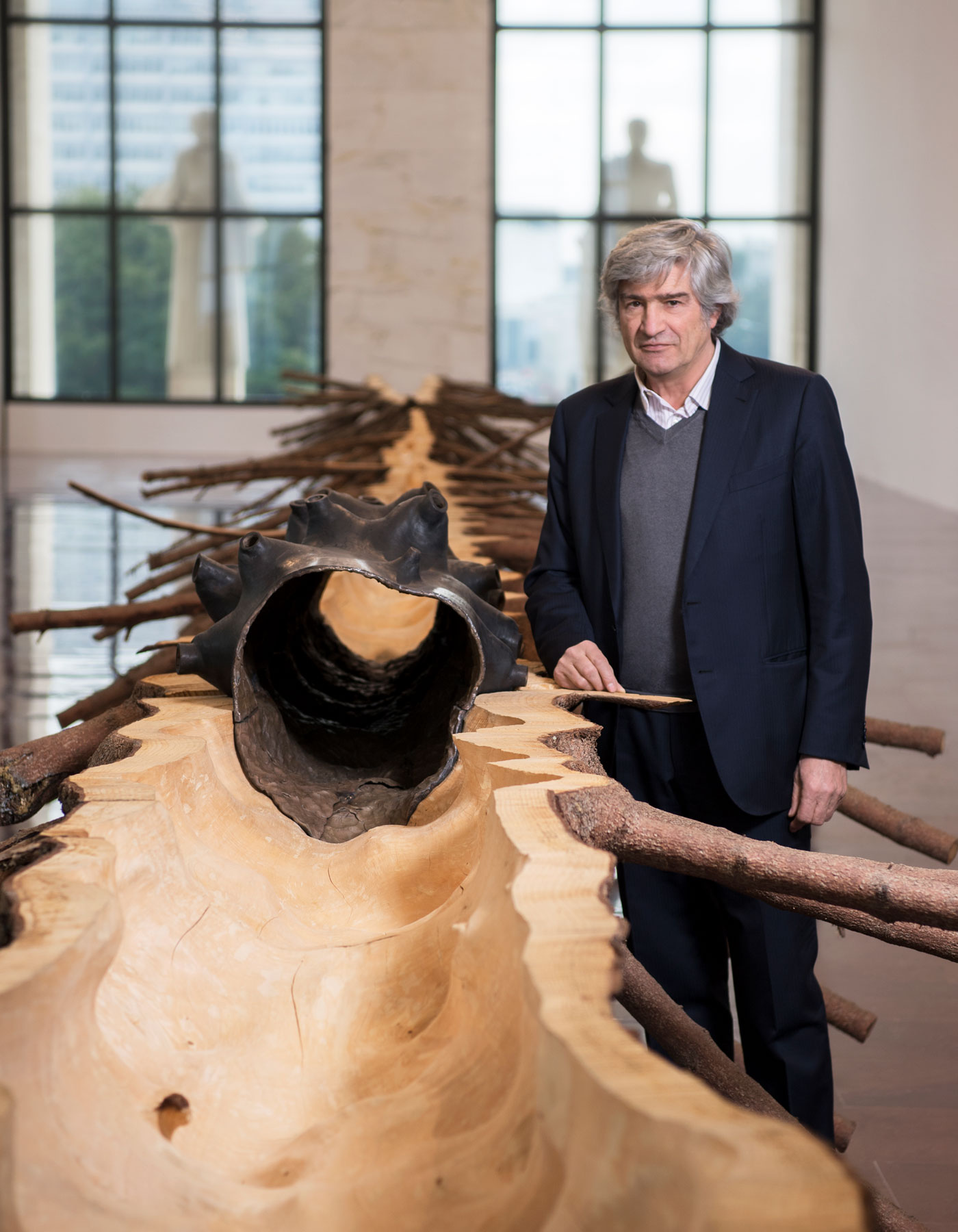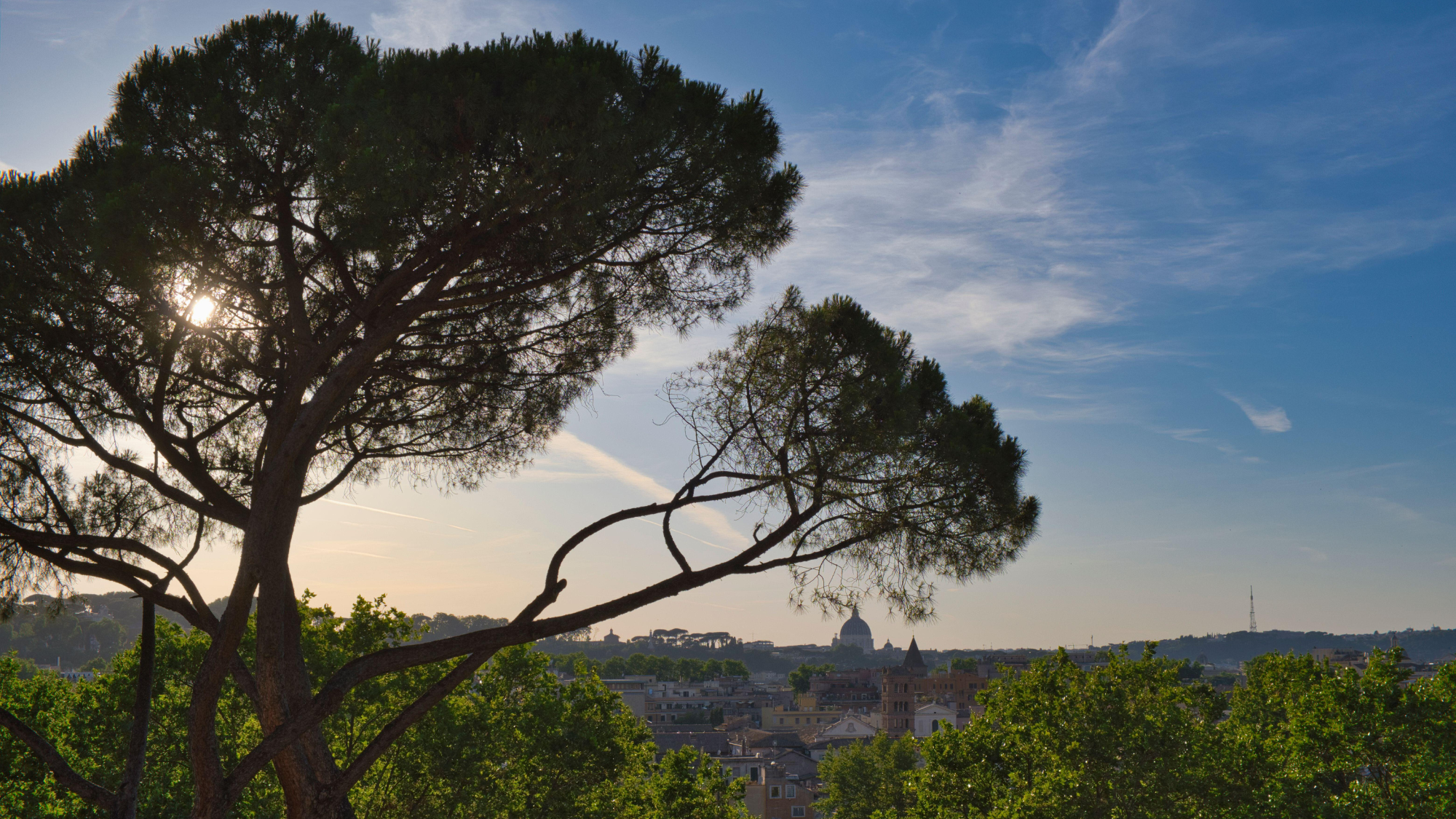Fendi's Return to Rome
How the fashion house is restoring the city’s Dolce Vita spirit

If you live or work in London, you may not be surprised by the sight of two tall trees made of bronze cradling an 11-ton marble block, the latest work by leading Italian sculptor Giuseppe Penone, which now stands outside Fendi’s flagship boutique in central Rome. Londoners, like New Yorkers and Parisians are accustomed to seeing public artworks of epic proportions:in May, Jeff Koons unveiled a 45ft-tall inflatable sculpture of a ballerina close to the Rockefeller Center; in London, we have Trafalgar Square’s famous fourth plinth, which early next year will support a giant winged bull by Iraqi-American artist Michael Rakowitz. Paris’ Louvre Pyramid was recently made to 'disappear' thanks to giant trompe l’oeil panelling created by French street artist and photographer JR.
In Rome, by contrast, public art funding is often a thorny issue, greeted with reticence by the authorities; there are numerous hoops to jump through in a city already struggling to preserve its heritage sites because of a lack of investment. Penone’s simple but striking work, Leaves of Stone, is therefore a significant one.
The work was commissioned by Fendi, the luxury fashion house that is taking steps to improve the look of the Eternal City. No doubt many of Rome’s annual visitors – estimated at more than seven million in 2016 – are too awestruck by its obvious beauty to notice the deepening cracks in the city’s most iconic monuments; in some cases, they are literally crumbling away. It appears that even Roman concrete (opus caementicium) – for many years a source of fascination to scientists, due to its durability – isn’t quite as eternal as once thought, although 2,000 years is pretty good going.
The Week
Escape your echo chamber. Get the facts behind the news, plus analysis from multiple perspectives.

Sign up for The Week's Free Newsletters
From our morning news briefing to a weekly Good News Newsletter, get the best of The Week delivered directly to your inbox.
From our morning news briefing to a weekly Good News Newsletter, get the best of The Week delivered directly to your inbox.
To wit, last year the city appealed to wealthy investors and companies to pitch in to help rejuvenate cultural heritage sites such the Forum, Circus Maximus and the city’s ancient aqueducts, all of which are in dire need of repair.
Fendi’s commitment to its founding city began long before the council made its SOS call; last year, the fashion house completed a 17-month restoration of the Trevi Fountain. Immortalised by Federico Fellini’s 1960 celluloid masterpiece La Dolce Vita, in which actress Anita Ekberg famously frolics in its waters, the landmark
was deemed by city councillors to be on the verge of collapse before Fendi’s intervention, said to have cost around €2.2million. The newly restored Baroque monument, originally commissioned by Pope Clement XII in 1730, was unveiled during Fendi’s 90th anniversary show in July last year. Models walked across a see-through plexiglass catwalk that had been placed temporarily over the fountain’s turquoise waters, which flow directly from the Acqua Vergine, one of the aqueducts that supplied ancient Rome with water. Considering the fountain’s papal origins and the show’s biblical reference to walking on water, it’s safe to say this project was more than merely a philanthropic gesture on Fendi’s part. Rather, it confirmed the influence of – and importance of providence to – the Italian label that started life in 1925 on Via del Plebiscito, just a 10-minute walk from where Penone’s tree sculpture stands tall on Largo Carlo Goldoni.
Let’s be clear, though: other fashion brands are pulling their weight, too. Renzo Rosso, the founder of Diesel, funded the restoration of the Ponte di Rialto, the oldest bridge spanning Venice’s Grand Canal, while Florence’s Boboli Gardens will be returned to their former splendour with the help of Gucci, which is pledging €2million to the project. Back in Rome, we have Bulgari to thank for the €1.5million rejuvenation of the Spanish Steps, and luxury shoemaker Tod’s for a whopping €25million injection to repair, clean and restore the Colosseum. The first stage of completion was celebrated last summer with a lavish concert conducted by maestro Zubin Mehta.
A free daily email with the biggest news stories of the day – and the best features from TheWeek.com
It stands to reason that fashion labels are singing their sponsorships loud and proud. Indeed, in June luxury goods magnate François Pinault, who leads the Kering group, announced plans to convert Paris’ 19th-century stock exchange building, the Bourse de commerce, into a modern art museum. His highly ambitious (read: costly) project will be spearheaded by Japanese architect Tadao Ando.
All things considered, then, why did Fendi’s sponsorship of Penone’s new tree sculpture gain as much media attention as Pinault’s grand plan to house his billion-dollar art collection?
For a start, Penone’s is the first permanent and public modern artwork in the centre of Rome. Secondly, Fendi CEO Pietro Beccari hand-picked Penone for the job. "We had a list of four artists," explains Beccari, himself a keen art collector. "I wanted Penone to be the winner. He has the merit of being an Italian artist, and really there is no living sculptor better than him at the moment."
Penone was a member of the late-1960s, early-’70s Arte Povera (Poor Art) movement, which was founded on the principle of aesthetic simplicity achieved through the use of organic and everyday materials. Now aged 70, the artist still works intensely, with just one assistant, casting enormous fallen tree trunks in bronze and marble. He is the ur-craftsman in a contemporary art world that increasingly favours show-stopping creations born of industrial methods, as proven by Jeff Koons’ giant ballerina and indeed JR’s optical illusion 'blanket' over the Louvre.

"My interest in bronze and marble is to do with stability," says Penone via an interpreter. The artist still lives and works in Turin and, despite a career spanning six decades, with his work exhibited worldwide, he speaks little English. "These materials last over a long period of time. They belong to the past and the future. In Rome, we are surrounded by art connected to the rhetoric of power – that of the Roman Empire – but I am interested in Rome’s connection with animism, the intimate nature of man and his relationship with nature."
Whatever you draw from Penone’s Leaves of Stone, which is best experienced up close, its strong but spindly bronze branches incongruously supporting a hefty slab of marble, it’s safe to say Fendi’s choice of artist goes against the grain. Louis Vuitton, which like Fendi is owned by LVMH, recently collaborated with Jeff Koons for its 'Masters' collection: bags and accessories adorned with the works of great artists, including Da Vinci’s Mona Lisa and Fragonard’s Girl With A Dog. On the arm of a customer, a handbag becomes a mobile artwork; a perversion of kitsch that raises questions about elitism, reproduction and the very concept of a luxury as something exclusive and original.

There’s an interesting duality here, and both artistic collaborations have their marketing – and academic – merits, but Fendi’s message is intentionally more ambiguous. It has less to do with concept, more to do with identity, which sits comfortably with Penone’s own artistic and philosophical motivations. Fendi is binding itself to its original source as a way of preserving its future.
As such, Beccari is taking giant leaps to reclaim Fendi’s Roman roots, and that means making bold decisions that nonetheless sit within a strong cultural remit. One of his first steps on joining in 2012 was to change the logo from Fendi to Fendi Roma – a move that draws on a romantic and celebrated but endangered past, when a ‘Made in Italy’ label was synonymous with world-class craftsmanship. Today, with so much rule bending applied to this one-time stamp of excellence – a garment can be assembled in Italy, but its parts made all around the world – Fendi is affirming its position as an exponent of true workmanship and craft.
"The name of Rome makes people dream," says Beccari. "People come here to discover the beauty of Rome, and as a brand associated with this beauty, we have to use it in a positive way. When customers come to a Fendi store, they want beautiful stories and to share the aesthetic values of the maison. So this is our way to declare that we are not just a brand that produces and sells products; we are a lifestyle."
While modernism is very much the commercial drive of the company – in 2014, it became the first fashion house to live-stream a collection using drones – Fendi is more patently patriotic about its city of origin than, say, Gucci or Valentino. The change of logo is a case in point; another is its choice of headquarters: the Palazzo della Civiltà Italiana, a huge marble monolith – christened the 'Square Colosseum'– on the industrial outskirts of the city and originally commissioned by Mussolini. Strength, power and autocracy are unavoidable associations when you take over a building with its foundations in fascism, but Fendi’s CEO rejected criticisms of insensitivity, claiming the choice of location was made purely on the merits of the Palazzo’s striking architecture.
To his credit, Beccari has helped drive out Il Duce’s ghost for good. The Palazzo is now one of Rome’s most-visited cultural destinations; its ground-floor art exhibitions – which, this summer, included a retrospective of Penone’s work – have attracted more than 100,000 visitors since Fendi moved here in 2015. Clout seems to have worked in the fashion house’s favour, and in rekindling the aura of a Dolce Vita lifestyle, Fendi has hit just the right balance of bravura and high culture.

-
 Why is Trump’s alleged strike on Venezuela shrouded in so much secrecy?
Why is Trump’s alleged strike on Venezuela shrouded in so much secrecy?TODAY'S BIG QUESTION Trump’s comments have raised more questions than answers about what his administration is doing in the Southern Hemisphere
-
 Vance’s ‘next move will reveal whether the conservative movement can move past Trump’
Vance’s ‘next move will reveal whether the conservative movement can move past Trump’Instant Opinion Opinion, comment and editorials of the day
-
 Why recognizing Somaliland is so risky for Israel
Why recognizing Somaliland is so risky for IsraelTHE EXPLAINER By wading into one of North Africa’s most fraught political schisms, the Netanyahu government risks further international isolation
-
 Ssh! Secret gardens to visit this summer
Ssh! Secret gardens to visit this summerThe Week Recommends These leafy havens are the perfect place to escape the crowds
-
 This week's dream: Exploring Rome's underground
This week's dream: Exploring Rome's undergroundFeature Beneath Rome's iconic landmarks lies a hidden world
-
 The battle to be named the world's oldest restaurant
The battle to be named the world's oldest restaurantUnder The Radar Two Madrid restaurants dispute the historical record but could both of their claims be cooked?
-
 The never-ending wonder of Pompeii
The never-ending wonder of PompeiiIn The Spotlight A luxury bathhouse is the latest treasure to be uncovered at the 'gift that keeps on giving'
-
 8 eagerly awaited hotels opening in 2025
8 eagerly awaited hotels opening in 2025The Week Recommends A new year means several anticipated hotel openings are on the horizon
-
 A solo weekend in Rome and the Vatican City
A solo weekend in Rome and the Vatican CityThe Week Recommends Slow down and enjoy the magnificent sights at your own pace
-
 Rome's Colossus of Constantine
Rome's Colossus of ConstantineIn the Spotlight British artist digitally reconstructs original from remaining fragments to create new statue of Roman emperor
-
 2023: the year of overtourism backlash
2023: the year of overtourism backlashThe Explainer People are traveling again … maybe too much